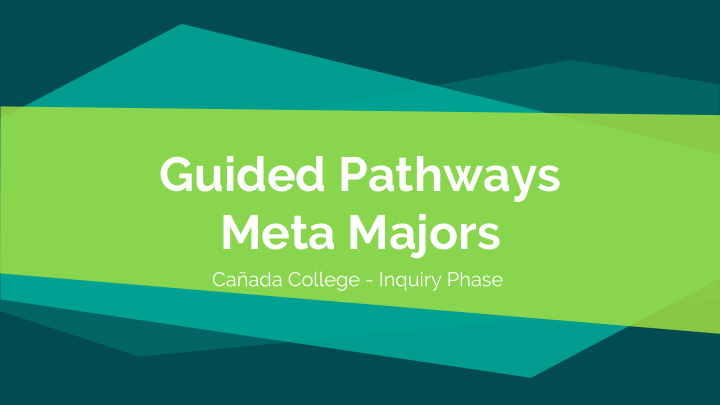



Guided Pathways Meta Majors Cañada College - Inquiry Phase
To begin: A little story about choice The Jam Jar Experiment 60% of customers were In 2000, in a Menlo Park First offering: 6 flavors of jam. drawn to the large supermarket, professors of assortment, while only psychology from Stanford Every few hours, they 40% stopped by the small set up a booth with jars of switched from offering a one. jam. selection of 6 jams to a group of 24 jams. 30% of the people who had Customers could taste as sampled from the six-jar many jams as they wanted assortment decided to buy jam, and received a coupon for while only 3% of those confronted On average, customers $1 off. with the two dozen jams tasted two jams, purchased a jar. regardless of the size of the assortment.
What does this have to do with GP? The “ paradox of choice ” : Too many choices leads to overwhelm, indecision, and frustration. Students entering into community college are overwhelmed with navigating the amount of choices available to them in what to study, which classes to take, what degree/certificate to earn, and where to transfer.
How is Cañada doing? • 16% of students complete their degree/certificate in 3-years • 52% of students complete their degree/certificate in 6 years • 58% of students that fail English 100 (a common first-semester course) in Fall do not return in Spring. • Students, on average, are attempting 118 units before earning a 60-unit Associate’s Degree. 2 2 Compiled by Cañada College’s Office of PRIE
What is Guided Pathways? College students are more likely Most community colleges use a to complete a degree efficiently 1 “ cafeteria ” model, allowing students if they: to choose from an abundance of choose an “ Area of Interest ” ◆ disconnected courses, programs, develop an academic plan ◆ and support services. follow a road map of the ◆ courses they need to take Students often have difficulty navigating receive guidance and ◆ these choices and end up making poor support to help them stay on decisions. Many drop out of college plan altogether. 1 Redesigning America’s Community Colleges by Bailey, Jaggers, and Jenkins
1. Meta Majors Areas of Interest or Career Groups
What are Meta Majors? Incoming students are given Meta Majors group degrees and support to explore their “area programs together thematically and of interest” based on potential help students to select one of the degrees or careers, choose a structured, educationally coherent program of study, and develop program maps that align with students’ an academic plan based on goals for careers and further education. program maps created by faculty and advisors. 1 Redesigning America’s Community Colleges by Bailey, Jaggers, and Jenkins
What are Program Maps? Program maps are NOT: Program maps helps students complete their required A highly regimented ◆ classes in ways that are sequence of courses thematically aligned, building Favoring certain subjects over ◆ upon the student’s stores of others knowledge while preparing “Pushing students through ◆ them to transfer successfully the degree factory” and/or enter the workforce. Inflexible: students can ◆ change pathways and even Meta Majors.
Benefits of Meta Majors and Program Maps Allow students to explore ◆ Give students clear and ◆ “areas of interest” before efficient paths to reach selecting a major. those goals. Help students understand, ◆ Ensure those paths are ◆ explore, and choose available. appropriate educational Provide support and ◆ goals. resources to keep students Reduces units that don’t ◆ on those paths. help students reach goals. Provide support to ◆ determine/refine goal during first semester.
The Big Picture What does this mean for Cañada?
How will Curriculum Committee be affected? Guided Pathways and Meta Over time, there will be ◆ ◆ Majors are student-facing. more analysis and evaluation of how to make courses more aligned with The purpose is to take the ◆ student goals. existing curriculum and clarify the path to completion or transfer for It is possible that some ◆ students, saving them time courses will need to be and money. revised to address student needs.
But why? It’s an equity issue
This Year in Meta Majors... Objectives: 1. Create general categories of 3. Consider meta-majors through the similar interest areas in which eyes and perspectives of our students, students can begin their career particularly through the experiences of and academic explorations. students who are new to college, first generation college students, low 2. Use language that is accessible, income students, and student who may clear, and inviting to students. question whether they belong in college.
Characteristics of Meta-Majors: ● student-facing and student-centered. use language that is engaging, clear, accessible, and ● draws students in. ● give students options, a place to begin their explorations in an area that interests them. be inviting and welcoming, and help create a sense of ● belonging for students.
Non-Characteristics of Meta-Majors: does not replace departments, divisions, or degrees ● not a major. not a realignment of curriculum. ● ● does not determine transferability. does not limit students’ choices or freedoms for ● academic/career explorations.
Thanks! Any questions? You can find me at wileym@smccd.edu Meta Major Mondays: 1st and 3rd Monday of each month in Building 3, Room 142 from 2:30-4pm.
How will Science and Tech faculty be involved? You’ve already done it! We still need your help! Congrats. The Guided Pathways team needs people with experience creating clear pathways to Our team is interested in using the transfer or degree completion. STEM model, including the Help us bring the success of resources like the STEM Center, Science and Tech to other Colts Con, STEM 3 and the clearly divisions. outlined program maps for majors in this division.
Recommend
More recommend